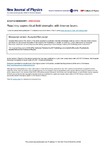Reaching supercritical field strengths with intense lasers
| dc.contributor.author | Blackburn, TG | en |
| dc.contributor.author | Ilderton, A | en |
| dc.contributor.author | Marklund, M | en |
| dc.contributor.author | Ridgers, CP | en |
| dc.date.accessioned | 2019-05-01T08:40:54Z | |
| dc.date.available | 2019-05-01T08:40:54Z | |
| dc.date.issued | 2019-04-30 | en |
| dc.identifier.issn | 1367-2630 | en |
| dc.identifier.uri | http://hdl.handle.net/10026.1/13757 | |
| dc.description.abstract |
It is conjectured that all perturbative approaches to quantum electrodynamics (QED) break down in the collision of a high-energy electron beam with an intense laser, when the laser fields are boosted to ’supercritical’ strengths far greater than the critical field of QED. As field strengths increase toward this regime, cascades of photon emission and electron-positron pair creation are expected, as well as the onset of substantial radiative corrections. Here we identify the important role played by the collision angle in mitigating energy losses to photon emission that would otherwise prevent the electrons reaching the supercritical regime. We show that a collision between an electron beam with energy in the tens of GeV and a laser pulse of intensity 10<sup>24</sup> Wcm<sup>−2</sup> at oblique, or even normal, incidence is a viable platform for studying the breakdown of perturbative strong-field QED. Our results have implications for the design of near-term experiments as they predict that certain quantum effects are enhanced at oblique incidence. | en |
| dc.language.iso | en | en |
| dc.publisher | IOP Publishing | en |
| dc.title | Reaching supercritical field strengths with intense lasers | en |
| dc.type | Journal Article | |
| plymouth.publisher-url | http://iopscience.iop.org/10.1088/1367-2630/ab1e0d | en |
| plymouth.journal | New Journal of Physics | en |
| dc.identifier.doi | 10.1088/1367-2630/ab1e0d | en |
| plymouth.organisational-group | /Plymouth | |
| plymouth.organisational-group | /Plymouth/Faculty of Science and Engineering | |
| plymouth.organisational-group | /Plymouth/REF 2021 Researchers by UoA | |
| plymouth.organisational-group | /Plymouth/REF 2021 Researchers by UoA/EXTENDED UoA 10 - Mathematical Sciences | |
| plymouth.organisational-group | /Plymouth/REF 2021 Researchers by UoA/UoA10 Mathematical Sciences | |
| dcterms.dateAccepted | 2019-04-30 | en |
| dc.rights.embargodate | 2019-11-27 | en |
| dc.rights.embargoperiod | Not known | en |
| rioxxterms.versionofrecord | 10.1088/1367-2630/ab1e0d | en |
| rioxxterms.licenseref.uri | http://www.rioxx.net/licenses/all-rights-reserved | en |
| rioxxterms.licenseref.startdate | 2019-04-30 | en |
| rioxxterms.type | Journal Article/Review | en |


